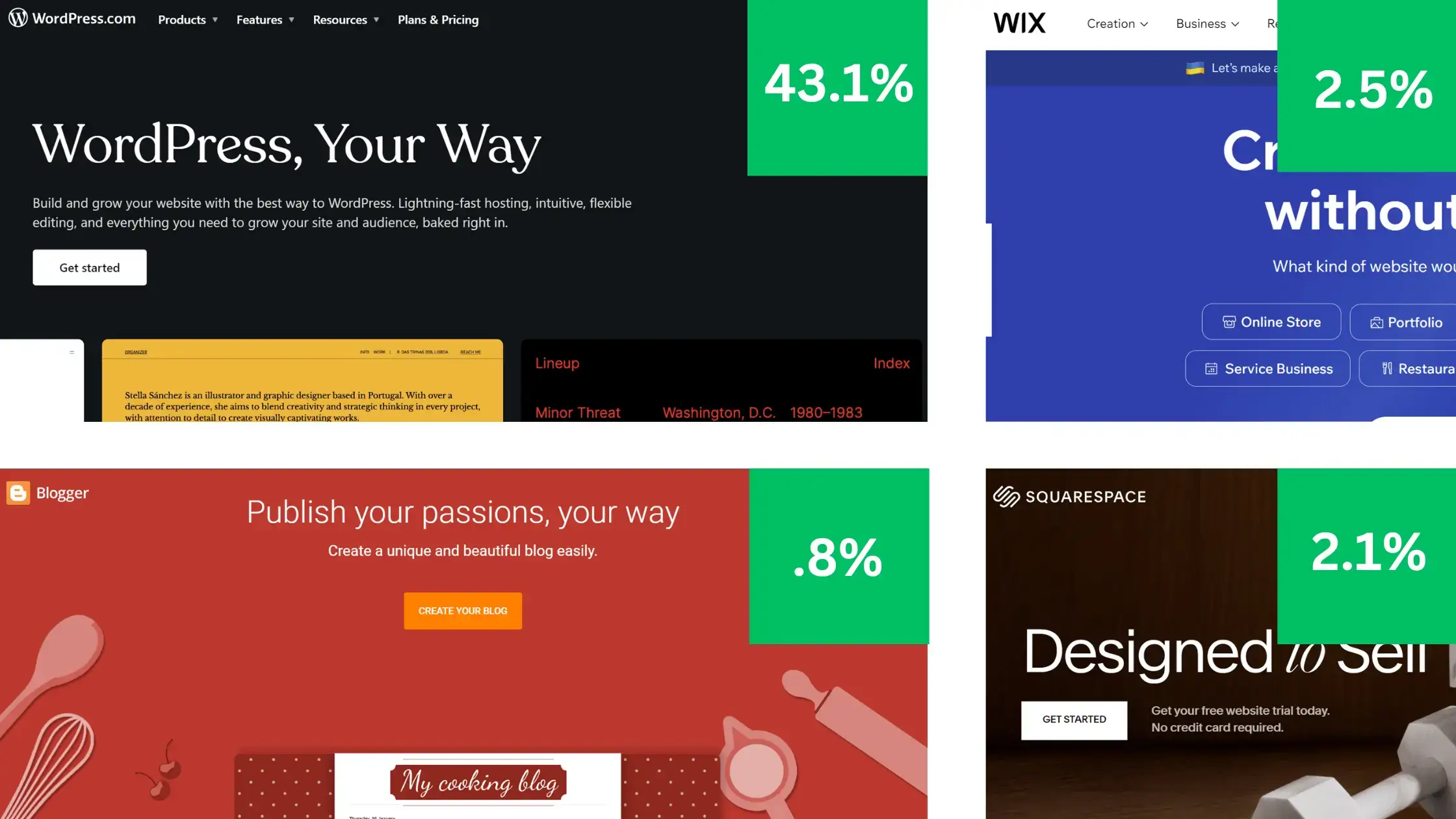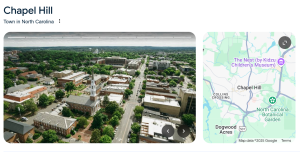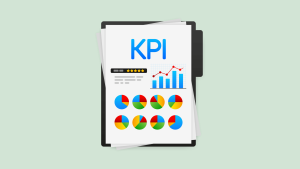Are you passionate about sharing your knowledge, experiences, or creativity with the world?
Starting a blog is an excellent way to express yourself and connect with a global audience.
But did you know that you can also turn your blog into a lucrative source of income?
In this guide, we’ll walk you through the process of starting a blog and monetizing it in 2023.
Whether you’re a seasoned writer or a complete beginner, this step-by-step guide will equip you with the knowledge and tools you need to succeed.
Step#1 Choose the right blogging platform
There are many blogging platforms available, but it can be overwhelming to determine which one is best suited for your needs.
Some popular Blogging Platform include:
- WordPress
- Blogger
- Squarespace
- Wix

Usage of the top content management systems (CMS) – w3techs
Now, we’ll explore the various features and benefits of different blogging platforms, empowering you to make an informed decision for your blogging journey.
WordPress:
The Powerhouse of Blogging WordPress stands as one of the most popular blogging platforms, and for good reason.
With its robust content management system (CMS) and endless customization options, WordPress gives bloggers complete control over their websites.
Its intuitive user interface makes it easy to create and publish engaging content without requiring technical expertise.
Moreover, WordPress offers an extensive library of plugins and themes, allowing you to personalize your blog to your heart’s content.
Blogger
Simplicity and Ease of Use For beginners and casual bloggers, Blogger is an excellent choice.
Powered by Google, this platform provides a simple and user-friendly interface that requires minimal setup.
With a few clicks, you can start sharing your stories and insights with the world.
Blogger also integrates seamlessly with other Google services, making it convenient for those already using Gmail or Google Drive.
While it may lack some advanced features, Blogger remains a reliable option for those seeking a hassle-free blogging experience.
Squarespace
Stylish Design Made Simple For bloggers with a keen eye for aesthetics, Squarespace offers a visually stunning platform.
Its elegant templates and intuitive drag-and-drop editor enable you to create a professional-looking blog with ease.
Whether you’re a photographer, artist, or fashion enthusiast, Squarespace provides a range of customizable designs to showcase your work.
Additionally, Squarespace includes built-in e-commerce functionality, allowing you to monetize your blog and sell products directly to your audience.
Wix
All-in-One Website Builder Wix caters to bloggers who desire a comprehensive website builder with blogging capabilities.
With its user-friendly interface and versatile design options, Wix allows you to create a fully functional website that incorporates a blog seamlessly.
The platform offers a wide range of templates, from business-oriented layouts to creative portfolios, empowering bloggers to showcase their unique style.
Wix also boasts powerful SEO features to help your blog gain visibility in search engine results.
Choosing the right blogging platform is very important to the success and enjoyment of your blogging journey.
Whether you prioritize flexibility, simplicity, community engagement, stylish design, or all-in-one functionality, there’s a platform that aligns with your specific needs.
By understanding the distinct features and benefits of each platform, you can confidently select the one that resonates with your vision and empowers you to share your voice with the world.
Begin your blogging adventure today and let your creativity flourish!
Step#2 Pick a hosting platform
Choosing the perfect hosting platform for your online presence is crucial.
It will impact your blog’s performance, reliability, and security.
Let’s dive into the process of making the right choice!
First, assess your blog’s specific requirements. Consider traffic volume, content type, and special features.
Next, prioritize performance and reliability. Look for providers with robust infrastructure and fast server response times.
Security is a top priority. Choose a platform with regular backups, SSL certificates, and firewall protection.
Ensure scalability options are available as your blog grows. You’ll need to accommodate increasing traffic and content.
A user-friendly interface is essential, especially for beginners. Look for intuitive control panels and easy-to-use interfaces.
Responsive customer support is crucial. You may encounter technical issues, so knowledgeable staff is essential.
While price isn’t everything, consider pricing and value for money. Compare plans and features offered.
To summarize, consider these factors when selecting a hosting platform for your blog:
- Requirements: Assess traffic, content type, and special features needed.
- Performance and Reliability: Look for fast servers and high uptime.
- Security Features: Ensure backups, SSL certificates, and firewalls are available.
- Scalability Options: Choose a platform that can handle growing traffic and content.
- User-Friendly Interface: Opt for easy-to-use control panels and interfaces.
- Customer Support: Responsive support with knowledgeable staff is crucial.
- Pricing and Value: Compare plans for affordability and quality.
By following these steps and considering the factors above, you can find the ideal hosting platform for your blog’s success and growth.
Remember to take your time, evaluate your options, and make an informed decision that aligns with your blogging goals.
Now that you’ve chosen the perfect hosting platform, the next step is selecting an engaging blog theme that reflects your content and appeals to your target audience. Stay tuned for our next article!
Step#3 Finding the Right Niche
A niche is the specific topic or subject area that your blog will focus on.
It is essential to choose a niche that aligns with your interests, expertise, and the needs of your target audience.
Now we will explore the importance of finding the right niche for your blog and provide you with valuable tips to guide you along the way.
Understand Your Passion and Expertise
Before diving into the world of blogging, take some time to reflect on your passions and areas of expertise.
What topics do you genuinely enjoy learning and writing about?
Your blog should be a platform to share your knowledge and insights with others, so it’s crucial to choose a niche that excites and motivates you.
When you are passionate about the subject matter, it will shine through in your writing and resonate with your readers.
Research the Market Demand
While it’s essential to blog about what you love, you also need to consider the market demand for your chosen niche.
Conduct thorough research to determine if there is an audience actively seeking information or content related to your niche.
Look for online forums, social media groups, and popular blogs in your potential niche to gauge the level of interest and engagement.
Understanding the market demand will help you assess the potential growth and monetization opportunities for your blog.
Narrow Down Your Niche
Once you have identified a broad topic of interest, consider narrowing it down further.
A niche that is too broad may make it challenging to stand out from the competition.
For example, instead of writing about “fitness,” you could focus on a specific aspect like “high-intensity interval training (HIIT) workouts for busy professionals.”
By narrowing down your niche, you can establish yourself as an authority in a particular subtopic and attract a dedicated audience.
Evaluate the Competition
Competition is inevitable in the blogging world, but it’s crucial to assess the competitive landscape in your chosen niche.
Analyze other blogs and websites that cover similar topics and evaluate their content, style, and audience engagement.
This research will help you identify gaps or opportunities that you can leverage to differentiate your blog.
Remember, it’s not about copying what others are doing but finding your unique angle and providing value in a way that sets you apart.
Consider Monetization Potential
While not everyone starts a blog with the goal of making money, it’s worth considering the monetization potential of your chosen niche.
Some niches naturally lend themselves to various monetization methods, such as affiliate marketing, sponsored content, or selling digital products.
Assess the income potential of your niche and determine if it aligns with your long-term goals.
However, don’t compromise the quality and integrity of your content solely for monetization purposes.
So, let’s get started on your blogging adventure and make an impact in your chosen niche!
Step#4 Select a blog name and domain
Your blog name and domain will be the foundation of your online presence and play a crucial role in attracting readers and establishing your brand.
In this section, we will guide you through the process of selecting the perfect blog name and domain for your unique voice and content.
Define Your Blog’s Focus
Before brainstorming blog names, it’s essential to have a clear understanding of your blog’s niche or topic.
Are you planning to share your expertise in cooking, fashion, technology, or any other specific area?
Knowing your focus will help you come up with a name that resonates with your target audience.
Reflect Your Blog’s Personality
Your blog name should reflect your blog’s personality and capture the essence of what readers can expect from your content.
Brainstorm keywords and phrases that are related to your blog’s topic and explore different combinations until you find a name that feels authentic and engaging.
Keep it Simple and Memorable
\When choosing a blog name, simplicity is key. Aim for a name that is easy to pronounce, spell, and remember.
Avoid using complex or lengthy words that might confuse your audience.
Think of popular blogs you admire and analyze their names for inspiration.
Research Domain Availability
Once you have a few blog name ideas, it’s time to check the availability of corresponding domain names.
The domain name is the web address where readers will find your blog.
Use domain registration websites to search for available options, and prioritize securing a “.com” domain as it is the most widely recognized and trusted extension.
Consider SEO
Search Engine Optimization (SEO) plays a vital role in driving organic traffic to your blog.
While selecting a blog name and domain, try incorporating relevant keywords that describe your blog’s topic.
This can improve your blog’s visibility in search engine results and attract more readers.
Avoid Copyright Infringement
To build a successful blog, it’s crucial to respect intellectual property rights.
Make sure the blog name and domain you choose do not infringe on any existing trademarks or copyrights.
Conduct a thorough search to ensure your chosen name is unique and legally available for use.
By following these steps, you’ll be well on your way to selecting an appealing blog name and securing a domain that perfectly represents your blog’s identity.
Remember, your blog’s name and domain are the building blocks of your online presence, so take your time, be creative, and choose wisely.
Step#5 Set up and design your blog
Congratulations on choosing your blogging and hosting platform, securing a domain name, and identifying your blog niche!
Now it’s time to roll up your sleeves and set up your blog.
In this section, we’ll guide you through the process of setting up and designing your blog, ensuring that it represents your unique style and captures the attention of your target audience.
Customize Your Blog Design
After selecting your blogging platform, it’s essential to customize the design of your blog to make it visually appealing and engaging.
Start by choosing a theme that aligns with your niche and reflects your brand’s personality.
Many blogging platforms provide a range of pre-designed templates that you can easily modify to suit your needs.
Take advantage of this opportunity to create a blog that stands out from the rest.
Craft a Captivating Logo
A well-designed logo can leave a lasting impression on your readers and help establish your blog’s identity.
Consider hiring a professional graphic designer to create a logo that conveys the essence of your blog.
Alternatively, if you have a knack for design, you can explore logo creation tools or online marketplaces where you can find customizable logo templates.
Ensure your logo is unique, eye-catching, and represents the theme of your blog effectively.
Choose an Appealing Color Scheme
Color plays a significant role in shaping the mood and perception of your blog.
Select a color scheme that complements your niche and evokes the desired emotions in your readers.
Stick to a limited palette of colors to maintain visual consistency throughout your blog.
Remember to consider accessibility standards, ensuring that your color choices accommodate individuals with visual impairments.
Decide Which Pages to Include
Before diving into designing your blog, it’s crucial to determine which pages you want to include.
Common pages on a blog typically include the home page, about page, contact page, and blog archives.
Additionally, depending on your blog’s purpose, you may consider including pages such as a resources page, services page, or product page.
Plan your site’s structure and navigation by identifying the essential pages that provide value and relevant information to your readers.
Create an Intuitive Navigation Menu
A well-organized and user-friendly navigation menu is crucial for guiding your visitors to different sections of your blog.
Keep it simple and logical, using clear labels that are easy to understand.
Incorporate drop-down menus if necessary, but avoid overwhelming your readers with too many options.
Aim for a seamless browsing experience, allowing your readers to find the information they’re looking for effortlessly.
Optimize for Mobile Devices
With the majority of internet users accessing content through their mobile devices, it’s essential to ensure your blog is mobile-friendly.
Choose a responsive theme that adapts to various screen sizes, enabling readers to enjoy your content on smartphones and tablets.
Test your blog’s responsiveness across different devices and make any necessary adjustments to optimize the mobile viewing experience.
Incorporate Engaging Visuals
Visual content can significantly enhance the overall appeal and engagement of your blog.
Use high-quality images, infographics, or videos to supplement your written content.
Images break up the text, making it more visually appealing and easier to digest.
Ensure that the visuals you choose are relevant to your content and evoke the desired emotions in your readers.
Include Social Sharing Buttons
Make it easy for your readers to share your blog posts on social media by incorporating social sharing buttons.
These buttons allow visitors to effortlessly share your content with their networks, expanding your reach and driving more traffic to your blog.
Place the buttons prominently, preferably at the beginning or end of your blog posts, to encourage social sharing.
Keep in mind that the look and how well your blog works are key factors in keeping visitors interested and eager to delve deeper into your content.
So invest time and effort into creating an aesthetically pleasing and user-friendly platform that reflects your unique voice and keeps readers coming back for more.
Popular Now – How to Measure and Track SEO Results
Step#6 Brainstorm blog topics
Now that you’ve laid the foundation for your blog by selecting the right blogging platform, hosting service, domain name, niche, and design it’s time to dive into the exciting world of brainstorming blog topics.
The success of your blog will largely depend on the quality and relevance of the content you provide to your readers.
So, let’s get those creative gears turning and explore some effective strategies for generating captivating blog ideas.
Conduct Keyword Research
Keywords are the driving force behind successful content.
Start by researching popular keywords related to your blog’s niche using tools like Google Keyword Planner, SEMrush, or Ahrefs.
This will help you identify the trending topics and frequently searched queries in your industry.
Incorporate these keywords into your blog posts to boost visibility and attract organic traffic.
Stay Informed About Industry Trends
Keeping up with the latest trends and news in your niche is crucial for creating engaging content.
Subscribe to industry-specific newsletters, follow influential bloggers, and join relevant online communities.
By staying informed, you’ll be able to spot emerging topics, industry debates, and current events that can inspire compelling blog posts.
Address Frequently Asked Questions
Take a moment to consider the most common questions people have about your niche.
What are the pain points they experience, and what solutions can you offer?
By addressing these frequently asked questions in your blog posts, you not only provide value to your readers but also position yourself as an authority in your field.
Share Personal Experiences and Stories
Injecting a personal touch into your blog can create a stronger connection with your audience.
Share your own experiences, anecdotes, or lessons learned within your niche.
This not only adds authenticity but also creates a relatable and engaging narrative for your readers.
Create “How-To” Guides and Tutorials
People are always seeking guidance and solutions to their problems.
By creating comprehensive “how-to” guides, tutorials, or step-by-step instructions, you can provide valuable assistance to your readers.
Break down complex processes into easily understandable steps, and use visuals or videos to enhance the learning experience.
Curate Expert Interviews and Opinions
Reach out to experts and thought leaders within your industry and request interviews or opinions on relevant topics.
Sharing insights from these experts can enrich your content and provide diverse perspectives.
It also offers an opportunity for cross-promotion and collaboration within your niche.
Conduct Surveys or Polls
Engage your readers by conducting surveys or polls on social media or within your blog.
Ask them about their preferences, challenges, or opinions related to your niche.
Not only will this provide valuable insights, but it will also help you understand your audience better and tailor your content to their needs.
Analyze Competitor Blogs
Don’t be afraid to explore what your competitors are doing.
Analyze their blog posts to identify gaps in their content or potential areas where you can offer a fresh perspective.
However, always strive to provide unique and valuable insights that differentiate your blog from others in the industry.
By utilizing these brainstorming strategies, you’ll be able to generate a wealth of blog topics that resonate with your audience.
Remember, consistency is key in blogging, so aim to create a content calendar and publish regularly to keep your readers engaged.
With a solid list of captivating blog topics in hand, you’re well on your way to building a successful and thriving blog.
Start brainstorming, get inspired, and let your creativity flow!
Step#7 Write your first blog post
Congratulations on setting up your blog!
Now that you have chosen a blogging and hosting platform, registered a domain name, identified your blog niche, and brainstormed blog topics it’s time to dive into creating your first blog post.
This is where you can unleash your creativity and start engaging with your readers.
In this section, we will explore some essential steps to help you write a captivating and successful first blog post.
Understand Your Audience
Before you begin writing, it’s crucial to understand who your target audience is.
Consider their interests, preferences, and needs.
By knowing your audience, you can tailor your content to resonate with them and provide value.
Choose a Compelling Topic
Brainstorming blog topics is an exciting part of blogging.
Think about what subjects within your niche are currently popular or trending.
Conduct research to identify common questions or challenges your audience might have.
Use tools like Google Trends or social media analytics to discover relevant topics that will capture your readers’ attention.
Craft an Engaging Introduction
Your blog post’s introduction sets the tone for the entire article and determines whether readers will continue reading or move on.
Start with a compelling hook that grabs their attention and entices them to read further.
Use an anecdote, a thought-provoking question, or a surprising statistic to pique their interest.
Provide Value and Solutions
Your blog post should offer valuable information or solutions to your readers’ problems.
Whether you’re sharing insights, providing tips, or offering step-by-step instructions, make sure your content is helpful, actionable, and relevant.
Be sure to back up your points with credible sources and personal experiences.
Use a Conversational Tone
Writing in a conversational tone makes your blog post more relatable and engaging.
Imagine you’re having a friendly conversation with your readers.
Avoid using jargon or overly complex language.
Instead, aim for clarity and simplicity, making your content accessible to a wide range of readers.
Break It Down with Subheadings
Use subheadings to break down your blog post into easily digestible sections.
This not only makes it visually appealing but also helps readers navigate through your content more efficiently.
Clear subheadings act as signposts, allowing readers to find the information they are most interested in.
Incorporate Visuals and Multimedia
A picture is worth a thousand words, and adding relevant visuals, such as images, infographics, or videos, can enhance the overall reading experience.
Visuals not only make your blog post more visually appealing but also help in conveying complex information effectively.
Include a Call to Action
A call to action (CTA) encourages readers to take a specific action after reading your blog post.
It could be subscribing to your newsletter, leaving a comment, sharing the post on social media, or exploring related content on your blog.
Incorporate clear and compelling CTAs throughout your article to engage your readers further.
Remember, your first blog post sets the tone for your entire blog, so put your best foot forward.
Write with passion, deliver value, and keep honing your writing skills as you progress. Starting a blog is an exciting journey, and your first blog post is just the beginning of sharing your voice with the world.
Now that you have the foundations for writing your first blog post, it’s time to put pen to paper (or fingers to the keyboard) and start crafting your engaging content. Good luck!
Stay tuned for the next section, where we’ll explore strategies for promoting your blog and attracting readership.
Step#8 Share your writeup with the world
Congratulations!
You have made significant progress in setting up your blog.
You have chosen the perfect blogging and hosting platform, registered a catchy domain name, identified your blog niche, brainstormed exciting blog topics, and even written your first captivating blog post.
Now it’s time to take the next step and share your valuable content with the world. In this section, we will explore effective strategies to increase your blog’s visibility and reach a wider audience.
Optimize your blog for search engines
To ensure your blog receives organic traffic, it’s crucial to optimize it for search engines.
Start by conducting keyword research relevant to your niche and incorporating those keywords naturally into your blog posts.
Craft compelling meta descriptions and title tags to entice users to click on your blog when it appears in search results.
Additionally, focus on improving your blog’s loading speed, mobile responsiveness, and overall user experience, as these factors also contribute to search engine rankings.
Utilize social media platforms
Leverage the power of social media to promote your blog and engage with your target audience.
Create dedicated social media profiles for your blog on popular platforms such as Facebook, Twitter, Instagram, or LinkedIn, depending on your niche.
Regularly share snippets or teasers of your blog posts along with catchy captions, relevant hashtags, and visually appealing graphics.
Engage with your followers by responding to comments and starting meaningful conversations.
Guest posting and collaborations
Collaborating with other bloggers or industry influencers can significantly boost your blog’s exposure.
Seek opportunities to write guest posts on established blogs within your niche.
When crafting your guest post, provide valuable and unique content that aligns with the host blog’s audience.
Include a compelling bio at the end of your post, with a link back to your blog.
This helps drive traffic from the host blog’s readership to your own site.
Email marketing and newsletter subscriptions
Build a loyal reader base by offering an email newsletter subscription to your blog.
Create valuable content exclusive to subscribers, such as bonus articles, e-books, or access to webinars.
Use a reliable email marketing service to manage your subscriptions and send out regular newsletters.
Include links to your recent blog posts, along with personalized messages and compelling subject lines, to entice subscribers to visit your blog.
Engage with the blogging community
Actively participate in the blogging community to expand your network and gain exposure.
Join forums, groups, or communities relevant to your niche, where you can share your expertise, ask questions, and connect with like-minded individuals.
Leaving thoughtful comments on other blogs can also help drive traffic back to your own blog.
Networking with fellow bloggers opens doors to collaboration opportunities, guest blogging invitations, and increased visibility within your niche.
Always keep in mind, that crafting a thriving blog requires dedication and perseverance.
By consistently producing top-notch, captivating content and promoting it strategically, you’ll build a devoted readership and expand your blog’s influence.
Embrace these strategies, adapt them to your blog’s unique requirements, and keep experimenting to find what works best for you.
The blogging journey is an exciting one, and with persistence, dedication, and the right promotion, your blog can flourish in the vast online world.
Keep writing, keep sharing, and keep inspiring others with your valuable insights!
Monetize your blog
Now that you have set up your blog and established a presence in the online world.
It’s time to explore how you can monetize your blog and turn your passion into a sustainable source of income.
In this section, we will discuss various strategies and methods that can help you generate revenue from your blog.
Advertising
One of the most common ways to monetize a blog is through advertising.
You can join advertising networks such as Google AdSense, which allows you to display relevant ads on your blog.
These ads can generate income based on the number of clicks or impressions they receive.
By strategically placing ads on your blog, you can earn money as your traffic grows.
Sponsored Content
Another effective way to monetize your blog is by collaborating with brands and publishing sponsored content.
As your blog gains popularity, companies may approach you to promote their products or services through sponsored posts.
You can create engaging and informative content that incorporates the brand’s message while providing value to your readers.
Sponsored content can be a lucrative source of income, especially if you establish long-term partnerships with reputable brands.
Affiliate Marketing
Affiliate marketing is a popular strategy that allows you to earn a commission by promoting products or services on your blog.
You can join affiliate programs related to your blog niche and incorporate affiliate links into your content.
When your readers make a purchase through those links, you earn a percentage of the sale.
It’s essential to choose affiliate products that align with your blog’s theme and provide genuine value to your audience.
Digital Products
Creating and selling your own digital products is an excellent way to monetize your expertise.
Depending on your niche, you can offer e-books, online courses, templates, or even exclusive membership content.
These products can be sold directly on your blog, providing a steady stream of income while establishing you as an authority in your field.
Sponsored Reviews
As your blog gains credibility, you might receive opportunities to write sponsored reviews for products or services.
In this case, companies pay you to review their offerings and share your honest opinion with your audience.
By maintaining transparency and integrity in your reviews, you can build trust with your readers and attract more sponsored review opportunities.
Consulting and Services
If you have specialized knowledge or skills related to your blog niche, consider offering consulting services or freelance work.
This can include one-on-one coaching, website design, content creation, or any other services that cater to your audience’s needs.
By leveraging your expertise, you can generate additional income while providing valuable assistance to others.
Remember, monetizing your blog requires time, effort, and consistency.
It’s crucial to focus on creating high-quality content and building a loyal readership before diving into monetization strategies.
As your blog grows and you implement these methods, track your progress and adapt your approach accordingly.
Stay dedicated, continue to engage with your audience, and explore new opportunities to maximize your blog’s earning potential.





